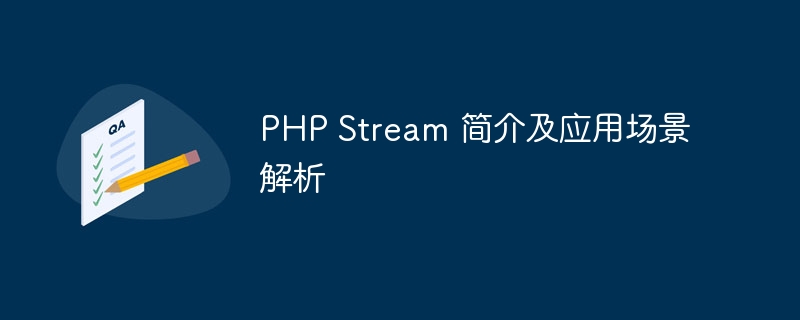Home >Backend Development >PHP Tutorial >Introduction to PHP Stream and analysis of application scenarios
Introduction to PHP Stream and analysis of application scenarios
- WBOYWBOYWBOYWBOYWBOYWBOYWBOYWBOYWBOYWBOYWBOYWBOYWBOriginal
- 2024-03-28 14:33:021113browse

Introduction to PHP Stream and analysis of application scenarios
1. Introduction to PHP Stream
PHP is a scripting language widely used in Web development, and PHP Stream is an important function in PHP for processing input and output operations. PHP Stream can simplify the operation of files, networks and other resources by providing an abstract data stream processing mechanism, and can implement different types of IO operations through a simple API interface.
PHP Stream has the following characteristics:
- Abstractness: PHP Stream provides a unified interface so that whether it is a file, network connection, string or other resource, it can be Access and operate in a similar manner.
- Scalability: PHP Stream can be expanded to support more transmission protocols and data sources, such as HTTP, FTP, memory, compressed files, etc.
- Flexibility: PHP Stream supports a variety of different IO operations, such as reading, writing, redirection, filtering, stream copying, etc., and can be easily applied to various scenarios.
2. PHP Stream application scenario analysis
- File reading and writing: PHP Stream can be used for file reading and writing operations, and can be opened and read through standard file streams and write to the file.
<?php
$handle = fopen("file.txt", "r");
while (!feof($handle)) {
$line = fgets($handle);
echo $line;
}
fclose($handle);
?>- Network operations: PHP Stream can be used to process various network resources, such as HTTP, FTP and other protocols. Through Stream Context, various options and configuration information can be set to achieve more flexible network operations.
<?php
$context = stream_context_create([
'http' => [
'header' => 'Content-type: application/json',
'method' => 'GET'
]
]);
$response = file_get_contents('http://api.example.com/data', false, $context);
echo $response;
?>- Data filtering: PHP Stream also supports the application of data filters, which can filter and convert data input and output to enhance data security and reliability.
<?php
$handle = fopen("file.txt", "r");
stream_filter_append($handle, 'string.toupper');
while (!feof($handle)) {
$line = fgets($handle);
echo $line;
}
fclose($handle);
?>- Other resource operations: PHP Stream can also be used to process other resources, such as memory data, compressed files, etc. The access and operation of different resources can be achieved through the corresponding Stream Wrapper.
<?php
$handle = fopen("compress.zlib:///path/to/compressed_file.txt", "r");
while (!feof($handle)) {
$line = fgets($handle);
echo $line;
}
fclose($handle);
?>Summary:
PHP Stream is a powerful and flexible input and output processing tool in PHP. Through the unified interface and rich functions it provides, it can be used in various scenarios. Apply and simplify IO operations. Developers can choose appropriate Stream operations based on specific needs to improve code maintainability and scalability, making PHP applications more robust and efficient.
The above is the detailed content of Introduction to PHP Stream and analysis of application scenarios. For more information, please follow other related articles on the PHP Chinese website!

